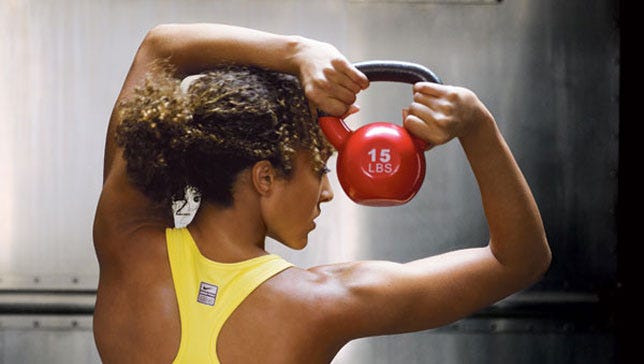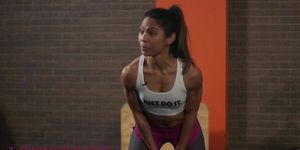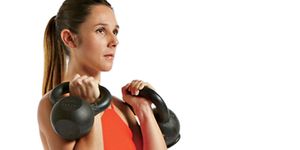
If you’ve eyed a cast-iron kettlebell at your gym and couldn’t imagine a use for it beyond doorstop, keep reading.
First things first: The kettlebell is that ball-shaped weight with a U-shaped handle. “That design means the center of gravity isn’t in the middle of the handle, like a dumbbell, but is constantly shifting depending on what movements you’re performing,” explains Melody Scharff, a NASM-certified personal trainer at The Fhitting Room in New York City. “This makes kettlebell training more difficult than dumbbell training.”
More difficult—but also more effective as a total-body training tool. “Because the center of gravity is constantly shifting, you’re building extra stability in your body—especially in the core and shoulders,” she says. “Lifts such as the kettlebell swing and clean have a lower-body focus, while lifts like presses and snatches really work your shoulders.”



A kettlebell exercise, though, is only as good as the form you do it with. “Most kettlebell movements are ballistic, meaning they move under the force of gravity, so you want to move with confidence,” says Scharff. “Make sure to finish most lifts in a tall stance, but never lean backward or push your pelvis forward.”
You can’t just grab any old kettlebell, either. First of all, there’s no “right” weight to use—the average weight depends on the person, says Scharff. “I would look at kettlebells as three weight groups: light, moderate, and heavy.” Then, think about the move you’re doing. “Different lifts require different weights,” says Scharff. “A lot of double-arm lifts are actually leg driven so people can go heavier than they may first realize. Whatever the move, start with a modest weight and work your way up.”
The best part about kettlebell workouts is the fact that you can combine a bunch for a solid, total-body routine, or you can hone in on a specific area. “For a full-body circuit, choose enough movements to hit all your major muscle groups and perform three rounds of those,” says Scharff. “Or, just pick two to three moves that target a specific body part and do three rounds of those within your regular workout.” Mix and match from the kettlebell exercises below!
1. Kettlebell Swing
How to do it: Grab a moderate-weight kettlebell with both hands and stand with your feet wider than hip-width apart. Push your hips back, bending your knees slightly to bring the weight between your legs. Squeeze your glutes and thrust your hips forward to swing the weight to shoulder height, keeping your arms straight and core tight. Reverse the movement, bringing the kettlebell between your legs. That’s one rep.
Recommended sets/reps: “I like to perform a pyramid of kettlebell swings. Start with 20 reps at a lighter weight, 15 at a moderate weight, and finish with 10 at a heavier weight,” says Scharff.
What it works: “This is a full-body move, especially targeting the glutes and hamstrings,” since your power comes from your lower body, says Scharff.
2. Single-Arm Kettlebell Swing
How to do it: Grab a moderate-weight kettlebell with one hand and stand with your feet wider than hip-width apart. Squat down until your thighs are nearly parallel to the floor, moving the weight between your legs. Thrust your hips forward, straighten your knees, and swing the kettlebell up to chest level, arm straight. Squat back down, swinging the weight between your legs. That’s one rep.
Recommended sets/reps: Perform three sets of eight to 12 reps on each side.
What it works: Just like the regular swing, this will target your whole body, especially your glutes and hamstrings. But “using just one arm will engage the lats of the working side,” says Scharff.
3. Kettlebell Deadlift Clean
How to do it: Stand with feet hip-width apart, a moderate-weight kettlebell on the floor between your feet. Squat down, keeping you back flat, and grab the kettlebell handle with one hand, your thumb pointing behind you. Quickly press through your heels to stand, and let the power from your explosive stand-up motion power the bell from the floor to your chest. The kettlebell should corkscrew around your wrist, landing in the center of the chest. Lower back to the ground and repeat.
Recommended sets/reps: Perform three sets of eight to 12 reps on each side.
What it works: “This move challenges your glutes, lats, and core,” says Scharff—your glutes are your power source, and the unilateral motion makes your lats and core work hard to stabilize.
4. Kettlebell Sumo Deadlift
How to do it: Stand with your feet shoulder-width apart, toes turned out about 45 degrees. Squat down and grab the handle of a heavy kettlebell with an overhand grip. Push through your heels firmly into the floor, and stand up, keeping your arms extended. That’s one rep.
Recommended sets/reps: Perform three sets of eight to 12 reps.
What it works: Your glutes, core, and back. “Sumo deadlifts really work your glutes and your adductors as you focus on squeezing your legs together without actually bringing your feet any closer,” says Scharff. “And your core and back engage to keep the kettlebell moving vertically and to keep your upper body in proper alignment.”
5. Romanian Deadlift With Kettlebell
How to do it: Start standing with feet hip-width apart, a heavy kettlebell on the floor right in between the arches of your feet. Grab the kettlebell with both hands, chest proud and shoulders higher than your hips. Squeeze your glutes to stand up, bringing the kettlebell along with you. Slowly lower back to start. That’s one rep.
Recommended sets/reps: Perform three sets of eight to 12 reps.
What it works: Your hamstrings, glutes, and back. “This deadlift challenges the hamstrings more than a sumo deadlift because your toes are pointing straight ahead and your legs are much more elongated than they would be for a sumo deadlift,” says Scharff. “You’ll feel your hamstrings stretch as you lower the bell, and your hamstrings and glutes contract to return to standing.”
6. Figure 8
How to do it: Stand with your feet wider than hip-width apart, knees bent into a quarter-squat position, back straight, and chest up. Hold a moderate-weight kettlebell behind your left leg with one arm on each side of your leg . Grab the bell with your left hand and swing it in front of your left leg, between your legs, and behind your right leg . Grab it with your right hand and swing it in front of your right leg, between your legs, then behind your left leg. That’s one rep.
Recommended sets/reps: Perform three sets of eight to 12 reps on each side.
What it works: “This is a hip- and lower-body dominant movement,” says Scharff. “It should feel similar to a swing, working your hips, core, biceps, and lats.”
7. Halo
How to do it: Start in a standing position, feet hip-width apart. Raise the kettlebell so that it’s in front of your chest and your arms are extended with your elbows bent. Keeping both elbows bent, and the rest of your body still, slowly circle the kettlebell around your head to your right. That’s one rep.
Recommended sets/reps: Perform three sets of eight to 12 reps in each direction.
What it works: By isolating the rest of your body’s movement, this move zeroes in on your triceps and shoulders.
8. Side Press
How to do it: Kneel on your left knee and hold a light kettlebell in your right hand. Press the kettlebell overhead while simultaneously leaning to the side, bringing your whole left palm to the floor. Return to start. That’s one rep.
Recommended sets/reps: Perform three sets of eight to 12 reps.
What it works: Pressing the kettlebell overhead while you’re in motion challenges your shoulder stability, while that sideways lean fires up your obliques.
9. Windmill
How to do it: Grab a light kettlebell with your left hand and stand with your feet more than hip-width apart, toes pointed to the left front corner of your workspace. Bring the weight next to your left shoulder, then press it overhead. Rotate your chest to the left and look up at the kettlebell as you try to touch your right foot with your right hand, pushing your hips back to the right corner of the room. Pause, then return to start, keeping your left arm extended.
Recommended sets/reps: Perform three sets of eight to 12 reps on each side.
What it works: Your shoulder stability, obliques, hamstrings, and more. “A windmill takes much more range of motion in the core, hips and hamstrings than most other kettlebell skills,” says Scharff. “You’re pushing hips back while bringing your upper body forward and to the side, so you’re working in all directions.”
10. Kettlebell Thruster
How to do it: Hold the handles of a moderate-weight kettlebell in the goblet position (in both hands, at your chest, elbows pointing straight down). Take a deep squat, then explosively stand up and immediately press the kettlebell overhead. That’s one rep.
Recommended sets/reps: Perform three sets of eight to 12 reps.
What it works: Like any squat, this engages your glutes as a power source; pressing the weight overhead engages your shoulders. “This should be performed in one swift movement rather than standing first and pressing second,” says Scharff.
11. Bent-Over Row With Kettlebell
How to do it: Place your right forearm on your right quad and step your left foot back so you can find a comfortable flat back position with the majority of your weight in your front foot. Holding a light kettlebell in your left hand, keep your shoulders level, and squeeze your left shoulder blade, pulling the left elbow up. The elbow should brush past your ribcage before lowering back down. That’s one rep.
Recommended sets/reps: Perform three sets of eight to 12 reps.
What it works: “The row targets your lats and backs,” says Scharff—and it’s a strength movement, not a momentum movement, so don’t crank the kettlebell up.
12. Deficit Pushup
How to do it: Get in a plank position with each hands on the handle of a kettlebell (these can be performed with either one side elevated or both). Bend your elbows, and lower your body down, until your chest is lower than your hands. Push back up. That’s one rep.
Recommended sets/reps: Perform three sets of eight to 12 reps.
What it works: A pushup is a chest and back-dominant exercise, and “the deficit creates more range of motion for your muscles to work through,” says Scharff.
13. Suitcase Lunge
How to do it: Start in a standing position, feet hip-width apart, holding two moderate-weight kettlebells by your side. Step the right foot backward in a reverse lunge, holding the kettlebells as still as possible and keeping your posture as upright as you can. Lower your knee to an inch above the floor, then drive through your left heel to return to start. That’s one rep.
Recommended sets/reps: Perform three sets of eight to 12 reps.
What it works: Lunges are one of the best exercises for your glutes and quads; adding weight forces your core to engage to help stabilize you as you move.
15. Kettlebell Goblet Clean
How to do it: Start in a sumo squat position with a heavy kettlebell between your feet. Place both hands on the top of the handle, arms straight. Explosively stand, driving through your heels, and allow that to power the kettlebell off the floor. Bring the bell to a goblet position in the center of your chest, elbows snapping down tight and fast. Slowly lower back to the floor. That’s one rep.
Recommended sets/reps: Perform three sets of eight to 12 reps.
What it works: Your glutes, lats, and shoulders. Your power is coming from your glutes, as you explosively stand, but your arms are doing the work to bring that kettlebell into your chest.
Source: Read Full Article
